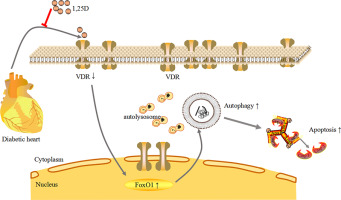The Journal of Nutritional Biochemistry ( IF 4.8 ) Pub Date : 2020-03-19 , DOI: 10.1016/j.jnutbio.2020.108380 Xiaoping Guo 1 , Hongkun Lin 1 , Jingjing Liu 1 , Dongxia Wang 1 , Dan Li 1 , Chunjie Jiang 1 , Yuhan Tang 1 , Jun Wang 2 , Tingrui Zhang 3 , Yanyan Li 2 , Ping Yao 1

|
Cardiovascular abnormalities are one of the most important complications associated with diabetes. However, the effect of 1, 25-dihydroxyvitamin D (1,25D) on the diabetic heart and the associated regulatory mechanisms are not well appreciated. Here, we report that activation of the vitamin D receptor (VDR) by 1,25D depresses autophagic activity by inhibiting nuclear FoxO1 translocation to attenuate diabetic heart damage. Treatment with 1,25D improved oral glucose tolerance test outcomes, fasting blood glucose levels and CK-MB release in Zucker diabetic fatty (ZDF, fa/fa) rats. Moreover, 1,25D intervention decreased the expression of Bcl-2, Bax, cleaved caspase-3, nuclear FoxO1, LC3II/LC3I and Beclin1 in the hearts of ZDF rats. However, VDR was noticeably up-regulated by 1,25D, which was inhibited in diabetic hearts. In the cardiomyocyte cell line H9c2, further accumulation of LC3II and the augmentation of p62 after treatment with high glucose and chloroquine confirmed increased autophagic activity in diabetic hearts. Moreover, increased Bcl-2 and Bax levels were observed after treatment with an agonist (rapamycin) and antagonist (3MA) of autophagy in high-glucose-cultured cells. The knockdown of VDR with siRNA further induced the expression of LC3II and FoxO1 translocation and altered the Bax/Bcl-2 ratio in high-glucose-exposed cells, and these effects were suppressed by treatment with 1,25D or an inhibitor of FoxO1 transcriptional activity. In summary, 1,25D supplementation attenuated diabetic heart-related cardiac autophagy and damage by activating the VDR to inhibit the nuclear translocation of FoxO1.
中文翻译:

1,25-二羟基维生素D通过维生素D受体介导的FoxO1易位抑制来减弱糖尿病性心脏自噬和损伤。
心血管异常是与糖尿病相关的最重要的并发症之一。但是,人们对1,25-二羟基维生素D(1,25D)对糖尿病心脏的影响以及相关的调节机制尚不十分了解。在这里,我们报告的维生素D受体(VDR)的激活由1,25D通过抑制核FoxO1易位以减轻糖尿病性心脏损害来抑制自噬活性。1,25D的治疗改善了Zucker糖尿病性脂肪(ZDF,fa / fa)大鼠的口服葡萄糖耐量测试结果,空腹血糖水平和CK-MB释放。此外,1,25D干预降低了ZDF大鼠心脏中Bcl-2,Bax,裂解的caspase-3,核FoxO1,LC3II / LC3I和Beclin1的表达。但是,VDR明显被1,25D上调,在糖尿病心脏中被抑制。在心肌细胞系H9c2中,高糖和氯喹治疗后LC3II的进一步积累和p62的增加证实了糖尿病心脏中自噬活性的增强。此外,在高糖培养细胞中,用自噬的激动剂(雷帕霉素)和拮抗剂(3MA)处理后,观察到Bcl-2和Bax水平升高。用siRNA敲低VDR进一步诱导了高糖暴露细胞中LC3II和FoxO1易位的表达并改变了Bax / Bcl-2的比率,而用1,25D或FoxO1转录活性抑制剂处理可抑制这些作用。总之,通过激活VDR抑制FoxO1的核易位,补充1,25D可以减轻与糖尿病心脏相关的心脏自噬和损伤。高糖和氯喹治疗后LC3II的进一步积累和p62的增加证实了糖尿病心脏中自噬活性的增强。此外,在高糖培养细胞中,用自噬的激动剂(雷帕霉素)和拮抗剂(3MA)处理后,观察到Bcl-2和Bax水平升高。用siRNA敲低VDR进一步诱导了高糖暴露细胞中LC3II和FoxO1易位的表达并改变了Bax / Bcl-2的比率,而用1,25D或FoxO1转录活性抑制剂处理可抑制这些作用。总之,通过激活VDR抑制FoxO1的核易位,补充1,25D可以减轻与糖尿病心脏相关的心脏自噬和损伤。高糖和氯喹治疗后LC3II的进一步积累和p62的增加证实了糖尿病心脏中自噬活性的增强。此外,在高糖培养细胞中,用自噬的激动剂(雷帕霉素)和拮抗剂(3MA)处理后,观察到Bcl-2和Bax水平升高。用siRNA敲低VDR进一步诱导了高糖暴露细胞中LC3II和FoxO1易位的表达并改变了Bax / Bcl-2的比率,而用1,25D或FoxO1转录活性抑制剂处理可抑制这些作用。总之,通过激活VDR抑制FoxO1的核易位,补充1,25D可以减轻与糖尿病心脏相关的心脏自噬和损伤。











































 京公网安备 11010802027423号
京公网安备 11010802027423号